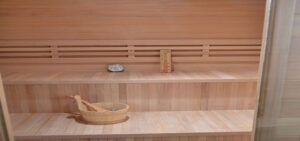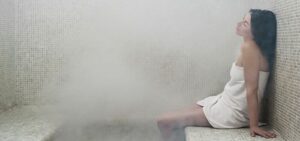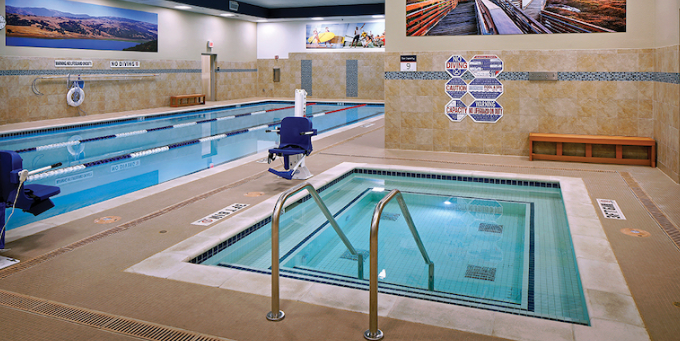You may observe quickly formed water droplets on your skin in a steam room. This happens due to water vapor saturation, which prevents sweat from evaporating effectively. In contrast to a sauna, where the climate is drier, this causes your body to continue producing sweat in an attempt to cool down, which results in greater sweating.
Even though you might have been aware that perspiration causes the body to cool through evaporation, knowing the scientific basis of this process, how much sweat is lost in saunas, and how to measure your sweat rate will help you understand it better. To learn more about these details, continue reading!
Table of Contents
Do you sweat more in a sauna or steam room?

If you have used a steam room, you have probably wondered if the water drips on your skin are condensation of water vapor or sweat. It is a combination of the two, where water droplets congregate on surfaces such as the skin’s surface that experience a lower temperature than the surrounding air. Sauna conditions and personal sweating habits, but perspiration probably has a greater impact than one may imagine.
People will sweat more after the sauna if the two are at the same degree. Sweating in an infrared outdoor sauna offers a unique and healthful experience. We will examine the causes of this occurrence in this section and even offer advice on how to carry out your investigation.
Sauna vs Steam Room
Steam rooms and saunas provide different relaxation and wellness experiences. Saunas offer a hot, dry environment that promotes perspiration and helps with muscle relaxation. Dry heat is frequently used to warm them. Lower humidity encourages efficient perspiration and evaporation, which aids in bodily cooling.
Steam rooms provide a humid environment that might seem drier by using moist heat from boiling water. A person’s taste for dry or wet heat generally determines whether they prefer a sauna or a steam room, even though both may cause perspiration and offer health advantages.
SWEATING IN A DRY SAUNA
Compared to steam rooms, saunas cause greater perspiration for two main reasons:
- Dry heat.
- Higher temperature.
Saunas usually run at 180°F, which is far hotter than wet steam rooms, which usually have a temperature of 110°F. Still, saunas’ low humidity level is a major factor in increasing sweat in addition to their high temperature. Hot tubs, in contrast to steam rooms, feature extremely low humidity levels, which speed up the process of perspiration from the skin evaporating into the dry air.
This process of evaporation cools the body effectively, which adds to the increased perspiration that occurs in spas. Even though both steam rooms and saunas provide comparable health and relaxation advantages, people usually prefer one over the other. Nevertheless, using a dry sauna would be a better option for people who want to get the most out of their perspiration session.
SWEATING IN A STEAM ROOM

Because steam rooms are so humid they sometimes reach 100% sweat has a unique feeling. The skin is very damp, which makes it difficult for sweat vapor to escape. Because the air in a steam chamber is saturated, it cannot take in more water, which makes evaporation more difficult. As a result, sweatdrops stay on the skin or spread across the body, reducing the body’s ability to produce an extensive sweat response similar to what happens in a dry sauna.
Why do you sweat more in a steam room than in a sauna?
Saunas and steam rooms are strongly linked to perspiration. The humidity in steam rooms is completely saturated with water vapor, which holds the key to the solution. Perspiration can’t evaporate into the existing saturated air in such an atmosphere, so it stays on the skin. As a result, the body continues to produce more sweat to control its body temperature, which results in an ongoing cycle of perspiration.
The incapacity of perspiration to disappear in steam rooms means that more perspiration builds up on the skin than in saunas, where the air is dry and permits sweating to escape more effectively. Because of this basic difference in moisture levels, you must perspire more in a room with steam than in a cedar sauna of similar temperature.
How much do you sweat in a sauna or steam room?
The quantity of perspiration generated in a sauna or steam room varies substantially based on personal digestion, level of hydration, temperature, and length of exposure. Still, it’s not common for people to perspire heavily in both situations.
According to some estimates, a regular bath or steam session lasting between 15 and 20 minutes can cause people to perspire as much as a liter. These numbers, however, are quite subjective and prone to large variation. To prevent dehydration both before and after using spas or steam rooms, it’s critical to maintain water and pay attention to your body’s cues.
What happens when you sweat?

Your body naturally reacts to a rise in temperature by starting to sweat in an attempt to cool you down. Your body’s millions of pores for perspiration come into action and release tiny droplets of water onto the surface of your skin. The process of vaporization produces a cooling effect. These droplets take up heat from your skin as they evaporate, changing from liquid to gas. This heat extraction procedure lowers body temperature and emphasizes how important perspiration is to the cooling process.
How can I measure the amount of sweat I produce in a sauna or steam room?
Although it might be difficult to estimate how much perspiration you create in a sauna or steam room, there are a few strategies you can try:
- Pre- and post-session weight: Measure yourself before and after your time in the sauna or steam room. The weight differential indicates how much fluid is lost through perspiration. Don’t forget to factor in any water you may have had during the workout.
- Sweat rate calculation: Calculate your rate by the time you spend in the sauna or steam room. Then, determine how much sweat you saw on your body and how hard you felt during the exercise to determine how much you sweated.
Your sweat rate is calculated as follows: total sweat loss (in grams) divided by total sweating time (in minutes).
- Perspiration patches: To visibly estimate the amount of perspiration absorbed, apply sensitive patches or materials to various body regions both before and after the activity. Instead of measuring sweat output directly, this approach measures it qualitatively.
- Hydration status: Before and after the session, note your general sense of hydration as well as variables like the color and frequency of your pee as well as your degree of thirst. This can help you gauge how much fluid you’re losing and how much you’re perspiring.
Although these techniques can provide you with some insight into how much perspiration you produce during spa or steam room events, it’s crucial to keep hydrated and pay attention to your body’s cues to avoid dehydration and guarantee a fun and safe experience.
Conclusion
When it comes to sweating, saunas, and steam rooms both provide unique benefits. Because of their higher levels and dry heat, spas usually cause more severe perspiration, whereas steam rooms provide a humid atmosphere that can also cause heavy sweating. In the end, intended results and personal preference will determine which option is selected.
To guarantee a safe and productive perspiration session, it is vital to keep hydrated and focus on your body’s signs, regardless of the choice you make. Both the humid climate of a steam room and the dry heat of a sauna may be helpful additions to a fitness program, offering relaxation, cleansing, and general health benefits.
FAQs
The most frequently asked questions are given below:
Which is healthier, a sauna or a steam room?
Spas and steam rooms have similar therapeutic effects on the skin and muscles. However, baths have been studied more thoroughly and are superior in terms of their effects on immunity, lifespan, cardiorespiratory health, and mental abilities. Be cautious and begin heat treatment gradually if you’re new to it.
Do you lose more weight in a steam room or sauna?
Saunas have a significant impact on weight loss by regulating lipids like fats and cholesterol. Both a sauna and a steam room can help with muscle healing. Bathrooms are frequently chosen as the favored weight loss option since many people believe they offer greater health advantages overall.
Are steam rooms full of bacteria?
Additionally, a steam room offers the perfect habitat for certain germs and bacteria to grow. Athletic feet and other bacterial infections that may flourish in warm, humid environments are instances of this danger. Therefore, before entering a steam room, it is suggested to wear a towel and sneakers or shower shoes.







